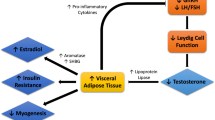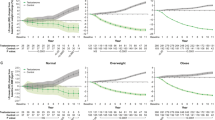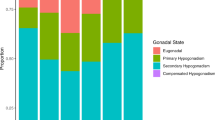Abstract
Clinicians have been aware of the increased prevalence of low testosterone levels in patients with type II diabetes for several years, but how these two conditions are associated is difficult to determine. Older age and obesity may be factors, as both are associated with type II diabetes and both decrease testosterone levels. Sex hormone-binding globulin (SHBG), the major serum carrier protein for testosterone, also may have an impact. SHBG levels fall with obesity and increase with aging. Some studies indicate lower SHBG levels in type II diabetes. Most of the differences in testosterone levels between diabetic and nondiabetic patients may be due to reduced SHBG, rather than reduced testosterone production. However, free testosterone levels fall with increasing age and obesity, rendering many type II diabetic patients testosterone deficient. Testosterone replacement may improve insulin sensitivity in hypogonadal, overweight men with type II diabetes by altering body composition, but studies are conflicting.
This is a preview of subscription content, access via your institution
Access options
Subscribe to this journal
Receive 8 print issues and online access
$259.00 per year
only $32.38 per issue
Buy this article
- Purchase on Springer Link
- Instant access to full article PDF
Prices may be subject to local taxes which are calculated during checkout


Similar content being viewed by others
References
Deslypere JP, Vermeulen A . Leydig cell function in normal men: effect of age, lifestyle, residence, diet, and activity. J Clin Endocrinol Metab 1984; 59: 955–962.
Gray A, Feldman HA, McKinlay JB, Longcope C . Age, disease, and changing sex hormone levels in middle-aged men: results of the Massachusetts Male Aging Study. J Clin Endocrinol Metab 1991; 73: 1016–1025.
Morley JE et al. Validation of a screening questionnaire for androgen deficiency in aging males. Metabolism 2000; 49: 1239–1242.
Perry III HM, Miller DK, Patrick P, Morley JE . Testosterone and leptin in older African-American men: relationship to age, strength, function, and season. Metabolism 2000; 49:1085–1091.
Morley JE et al. Longitudinal changes in testosterone, luteinizing hormone, and follicle-stimulating hormone in healthy older men. Metabolism 1997; 46: 410–413.
Harman SM et al. Longitudinal effects of aging on serum total and free testosterone levels in healthy men. Baltimore Longitudinal Study of Aging. J Clin Endocrinol Metab 2001; 86: 724–731.
Feldman HA et al. Age trends in the level of serum testosterone and other hormones in middle-aged men: longitudinal results from the Massachusetts Male Aging Study. J Clin Endocrinol Metab 2002; 87: 589–598.
Tenover JS, Matsumoto AM, Plymate SR, Bremner WJ . The effects of aging in normal men on bioavailable testosterone and luteinizing hormone secretion: response to clomiphene citrate. J Clin Endocrinol Metab 1987; 65: 1118–1126.
Haffner SM et al. Decreased sex hormone-binding globulin predicts noninsulin-dependent diabetes mellitus in women but not in men. J Clin Endocrinol Metab 1993; 77: 56–60.
Haffner SM et al. Low levels of sex hormone-binding globulin and testosterone predict the development of non-insulin-dependent diabetes mellitus in men. MRFIT Research Group. Multiple Risk Factor Intervention Trial. Am J Epidemiol 1996; 143: 889–897.
Stellate RK et al. Testosterone, sex hormone-binding globulin, and the development of type 2 diabetes in middle-aged men: prospective results from the Massachusetts Male Aging Study. Diabetes Care 2000; 23: 490–494.
Oh JY, Barrett-Connor E, Wedick NM, Wingard DL . Endogenous sex hormones and the development of type 2 diabetes in older men and women: the Rancho Bernardo Study. Diabetes Care 2002; 25: 55–60.
Barrett-Connor E, Khaw KT, Yen SS . Endogenous sex hormone levels in older adult men with diabetes mellitus. Am J Epidemiol 1990; 132: 895–901.
Tan RS, Pu SJ . Impact of obesity on hypogonadism in the andropause. Int J Androl 2002; 25: 195–201.
Goodman-Gruen D, Barrett-Connor E . Sex differences in the association of endogenous sex hormone levels and glucose tolerance status in older men and women. Diabetes Care 2000; 23: 912–918.
Couillard C et al. Contribution of body fatness and adipose tissue distribution to the age variation in plasma steroid hormone concentrations in men: the HERITAGE Family Study. J Clin Endocrinol Metab 2000; 85: 1026–1031.
Forbes GB, Reina JC . Adult lean body mass declines with age: some longitudinal observations. Metabolism 1970; 19: 653–663.
Gallagher D et al. Weight stability masks sarcopenia in elderly men and women. Am J Physiol Endocrinol Metab 2000; 279: E366–E375.
Plymate SR, Matej LA, Jones RE, Friedl KE . Inhibition of sex hormone-binding globulin production in the human hepatoma (Hep G2) cell line by insulin and prolactin. J Clin Endocrinol Metab 1988; 67: 460–464.
Abate N et al. Sex steroid hormones, upper body obesity, and insulin resistance. J Clin Endocrinol Metab 2002; 87: 4522–4527.
Adlercreutz H et al. Effect of dietary components, including lignans and phytoestrogens, on enterohepatic circulation and liver metabolism of estrogens and on sex hormone binding globulin (SHBG). J Steroid Biochem 1987; 27: 1135–1144.
Lovejoy JC et al. Effects of experimentally induced mild hyperthyroidism on growth hormone and insulin secretion and sex steroid levels in healthy young men. Metabolism 1997; 46: 1424–1428.
Selby C . Sex hormone binding globulin: origin, function and clinical significance. Ann Clin Biochem 1990; 27 (Part 6): 532–541.
Motta E . [Epilepsy and hormones]. Neurol Neurochir Pol 2000; 33 (Suppl 1): 31–36.
Andersson B et al. Testosterone concentrations in women and men with NIDDM. Diabetes Care 1994; 17: 405–411.
Strain GW et al. Effect of massive weight loss on hypothalamic-pituitary-gonadal function in obese men. J Clin Endocrinol Metab 1988; 66: 1019–1023.
Bastounis EA et al. Sex hormone changes in morbidly obese patients after vertical banded gastroplasty. Eur Surg Res 1998; 30: 43–47.
Schneider G, Kirschner MA, Berkowitz R, Ertel NH . Increased estrogen production in obese men. J Clin Endocrinol Metab 1979; 48: 633–638.
Vermeulen A, Kaufman JM, Deslypere JP, Thomas G . Attenuated luteinizing hormone (LH) pulse amplitude but normal LH pulse frequency, and its relation to plasma androgens in hypogonadism of obese men. J Clin Endocrinol Metab 1993; 76: 1140–1146.
Zumoff B et al. Partial reversal of the hypogonadotropic hypogonadism of obese men by administration of corticosuppressive doses of dexamethasone. Int J Obes Relat Metab Disord 1988; 12: 525–531.
Blank DM et al. Endogenous opioids and hypogonadism in human obesity. Brain Res Bull. 1994; 34: 571–574.
Lima N et al. Decreased androgen levels in massively obese men may be associated with impaired function of the gonadostat. Int J Obes Relat Metab Disord 2000; 24: 1433–1437.
Pasquali R et al. Insulin regulates testosterone and sex hormone-binding globulin concentrations in adult normal weight and obese men. J Clin Endocrinol Metab 1995; 80: 654–658.
Pasquali R et al. Effects of acute hyperinsulinemia on testosterone serum concentrations in adult obese and normal-weight men. Metabolism 1997; 46: 526–529.
Oltmanns KM et al. Hypoglycemia, but not insulin, acutely decreases LH and T secretion in men. J Clin Endocrinol Metab 2001; 86: 4913–4919.
Salardi S et al. Inhibin B levels in adolescents and young adults with type 1 diabetes. Horm Res 2002; 57: 205–208.
Christensen L, Hagen C, Henriksen JE, Haug E . Elevated levels of sex hormones and sex hormone binding globulin in male patients with insulin dependent diabetes mellitus. Effect of improved blood glucose regulation. Dan Med Bull 1997; 44: 547–550.
Bhasin S et al. Effects of testosterone replacement with a nongenital, transdermal system, Androderm, in human immunodeficiency virus-infected men with low testosterone levels. J Clin Endocrinol Metab 1998; 83: 3155–3162.
Bhasin S et al. Testosterone replacement and resistance exercise in HIV-infected men with weight loss and low testosterone levels. JAMA 2000; 283: 763–770.
Katznelson L et al. Increase in bone density and lean body mass during testosterone administration in men with acquired hypogonadism. J Clin Endocrinol Metab 1996; 81: 4358–4365.
Rolf C, von Eckardstein S, Koken U, Nieschlag E . Testosterone substitution of hypogonadal men prevents the age-dependent increases in body mass index, body fat and leptin seen in healthy ageing men: results of a cross-sectional study. Eur J Endocrinol 2002; 146: 505–511.
Snyder PJ et al. Effect of testosterone treatment on body composition and muscle strength in men over 65 years of age. J Clin Endocrinol Metab 1999; 84: 2647–2653.
Mårin P et al. Androgen treatment of abdominally obese men. Obes Res 1993; 1: 245–251.
Simon D et al. Androgen therapy improves insulin sensitivity and decreases leptin level in healthy adult men with low plasma total testosterone: a 3-month randomized placebo-controlled trial. Diabetes Care 2001; 24: 2149–2151.
Mokdad AH et al. Prevalence of obesity, diabetes, and obesity-related health risk factors, 2001. JAMA 2003; 289: 76–79.
Skin patch replaces testosterone. Updates—January–February 1996 FDA Consumer. 1996. http://www.fda.gov/fdac/departs/196_upd.html. Accessed February 14, 2003.
Pardridge WM . Transport of protein-bound hormones into tissues in vivo. Endocr Rev 1981; 2: 103–123.
Author information
Authors and Affiliations
Corresponding author
Rights and permissions
About this article
Cite this article
Betancourt-Albrecht, M., Cunningham, G. Hypogonadism and diabetes. Int J Impot Res 15 (Suppl 4), S14–S20 (2003). https://doi.org/10.1038/sj.ijir.3901031
Published:
Issue Date:
DOI: https://doi.org/10.1038/sj.ijir.3901031
Keywords
This article is cited by
-
The genetics of testosterone contributes to “femaleness/maleness” of cardiometabolic traits and type 2 diabetes
International Journal of Obesity (2022)
-
Differences in the relationship between diabetes and prostate cancer among Black and White non-Hispanic men
Cancer Causes & Control (2021)
-
Association of total and calculated free testosterone with androgen deficiency symptoms in patients with type 2 diabetes
International Journal of Impotence Research (2020)
-
Examining the relationship between diabetes and prostate cancer through changes in screening guidelines
Cancer Causes & Control (2020)
-
Effects of hyperglycemia on the progression of tumor diseases
Journal of Experimental & Clinical Cancer Research (2019)



